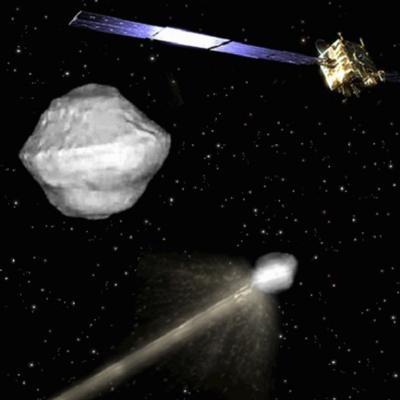Fri, Jan 18, 2013
Seeking Improved Understanding Of High-Speed Collisions Between Natural And Man-Made Objects
A space rock several hundred metres across is heading towards our planet and the last-ditch attempt to avert a disaster – an untested mission to deflect it – fails. This fictional scene of films and novels could well be a reality one day. But what can space agencies do to ensure it works?

ESA is seeking research ideas to help guide the development of a US–European asteroid deflection mission now under study.
Concepts are being sought for both ground- and space-based investigations, seeking improved understanding of the physics of very high-speed collisions involving both man-made and natural objects in space. ESA’s call will help to guide future studies linked to the Asteroid Impact and Deflection mission – AIDA. This innovative but low-budget transatlantic partnership involves the joint operations of two small spacecraft sent to intercept a binary asteroid. The first Double Asteroid Redirection Test (DART) spacecraft, designed by the US Johns Hopkins Applied Physics Laboratory will collide with the smaller of the two asteroids.
Meanwhile, ESA’s Asteroid Impact Monitor (AIM) craft will survey these bodies in detail, before and after the collision. The impact should change the pace at which the objects spin around each other, observable from Earth. But AIM’s close-up view will ‘ground-truth’ such observations. “The advantage is that the spacecraft are simple and independent,” says Andy Cheng of Johns Hopkins, leading the AIDA project on the US side. “They can both complete their primary investigation without the other one.”
But by working in tandem, the quality and quantity of results will increase greatly, explains Andrés Gálvez, ESA AIDA study manager: “Both missions become better when put together – getting much more out of the overall investment. “And the vast amounts of data coming from the joint mission should help to validate various theories, such as our impact modeling.”
(ESA image artist's concept of AIDA mission)
More News
Charted Visual Flight Procedure Approach An approach conducted while operating on an instrument flight rules (IFR) flight plan which authorizes the pilot of an aircraft to proceed >[...]
“When l became the Secretary of Defense, I committed to rebuild our military to match threats to capabilities. Drones are the biggest battlefield innovation in a generation, >[...]
Aero Linx: Stearman Restorers Association Welcome to the Stearman Restorers Association. The Stearman Restorers Association is an independent “Not for Profit” 501C-3 Co>[...]
Airplane Exhibited A Partial Loss Of Engine Power When It Was About Halfway Down The Runway Analysis: The pilot of the experimental amateur-built airplane was departing from his pr>[...]
The Flight Path Was Consistent With Low-Altitude Maneuvering On June 18, 2025, about 0922 mountain standard time, a Cessna A150L airplane, N6436F, was substantially damaged when it>[...]
 ANN's Daily Aero-Term (07.15.25): Charted Visual Flight Procedure Approach
ANN's Daily Aero-Term (07.15.25): Charted Visual Flight Procedure Approach Aero-News: Quote of the Day (07.15.25)
Aero-News: Quote of the Day (07.15.25) ANN's Daily Aero-Linx (07.15.25)
ANN's Daily Aero-Linx (07.15.25) NTSB Final Report: Kjelsrud Gary Kitfox
NTSB Final Report: Kjelsrud Gary Kitfox NTSB Prelim: Cessna A150L
NTSB Prelim: Cessna A150L



